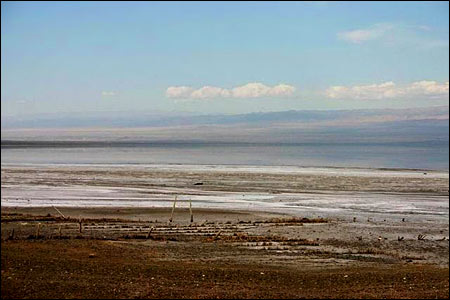Aibi Lake (File photo)
Due to shrinking surface area, Xinjiang's largest salt lake, Aibi Lake, has increased the desertification of the area and subsequently transformed into one of China's major sandstorm sources.
Down to just 500 square kilometers from its original 1,200, Aibi Lake has become a direct threat to the sustainable development of the Economic Belt on the northern slope of the Tianshan Mountains and the security of the new Euro-Asian Continental Bridge.
With the smaller surface area, water resources from the lake have been reduced to 600 million cubic meters from 3 billion cubic meters. Shrinkage has also increased the salt content of the lake water yearly, which has now reached 3 percent, close to the average salt content of seawater.
The decrease in water has transformed the surrounding areas of Aibi Lake into a 1,500-square-meter desert belt, expanding at a speed of 39.8 square meters per year. Under the hot sun, large amounts of salt become particles less than 0.02 microns in diameter at the dried lake bottom.
According to the Xinjiang Environmental Protection Bureau, these tiny salt particles are more easily blown into the air than sand dust. Each year more than 4.8 million tons of salt dust is blown from the Aibi Lake area. The strong wind from Alataw Mountain Pass may blow them more than 5,000 kilometers away, constituting a big threat to the plants, crops, and people of all northern China.
According to Gao Xiang, Party chief of the Aibi Lake Wetland Nature Reserve Administration, the salt dust has accelerated the melting of glaciers in Bortala Prefecture, where the sandstorm weather has risen to 110 days from 13 days since the 1960s.
Gao said that the Aibi Lake Wetland Nature Reserve had 385 kinds of wild plants registered, but a 2005 investigation showed that there are only 322 kinds of plants left. The nature reserve has 111 kinds of bird species, numbering 1 million in total, but a strong wind could kill more than 10,000.
"If the comprehensive ecological treatment of the Aibi Lake area succeeds, it will erect an ecological protection shelter in northern Xinjiang; if it fails, the salt dust will directly threaten the ecological environment of the Hexi Corridor and all North China," Gao remarked.
Aibi Lake (File photo)
According to the Bortala Forestry Bureau, water shortages have led to the shrinkage of the Aibi Lake surface. Three rivers including the Kuytun, which previously supplied 45.8 percent of the Aibi Lake water, dried up in the 1970s. Reduced supply of river water combined with severe lack of rain, about 90 mm per year, has caused a serious imbalance between the supply of lake water and evaporation.
Each year 713 million cubic meters of lake water evaporates, but the average water supply to the lake is only 662 million cubic meters. In addition, the increased population and expanded irrigation areas after the 1970s also sped up the shrinkage of the lake surface.
Various measures have been enacted to help solve the ecological problems around Aibi Lake including water conservation, tree planting and a limit on logging and hunting to protect the lake.
"The fundamental ecological problem of Aibi Lake is a water shortage," noted Wang Xinhe, a member of the Bortala People's Congress Standing Committee.
In order to maintain the existing Aibi Lake surface, the prefecture saves 20 million cubic meters of water per year to guarantee a water supply of 600 million cubic meters to the lake. But Bortala is running short of water resources with its economic and social development.
Wang Xinhe said helplessly, "Bortala's limited water resources are far from satisfying the water supply to Aibi Lake. The current situation constitutes a massive pressure to the sustainable development of the prefecture's society and economy and the coordinating development of population, resources, and environment."
According to preliminary estimates, an additional 1 billion cubic meters of water is needed to cover the dried lake bottom and deal with the surrounding deserts.
In 2004 Xinjiang launched a water project in the Aibi Lake area. Phase I of the project with a total input of 20 million yuan, will be accomplished by 2010. Each summer and winter, related institutions will fire rain enhancement devices using rockets or artillery to supply more water to the lake.
The air over Aibi Lake contains abundant vapor water and tuning this vapor water into liquid water will effectively supply water to Aibi Lake, according to the Xinjiang meteorological department.
"In the long run, in order to win the battle to protect the lake, water transfer projects must be put on the agenda," Wang Xinhe explained. Inter-basin water transfers can increase the water volume of Aibi Lake, extend its surface, elevate its underground water level, and maintain and develop existing plants around the lake area.
"Currently the deterioration speed of the Aibi Lake ecological environment is much faster than the improvement speed. Protection of the Aibi Lake area requires the concerted efforts of people from all walks of life," Wang added.
(China.org.cn by Zhang Ming'ai, November 30, 2007)







